Challenges of Upstream Oil Exploration Sector in Somalia
37 Pages14176 Words35 Views
Added on 2020-02-05
Challenges of Upstream Oil Exploration Sector in Somalia
Added on 2020-02-05
ShareRelated Documents
To identify different challenges of upstream oil
exploration sector in Somalia
exploration sector in Somalia
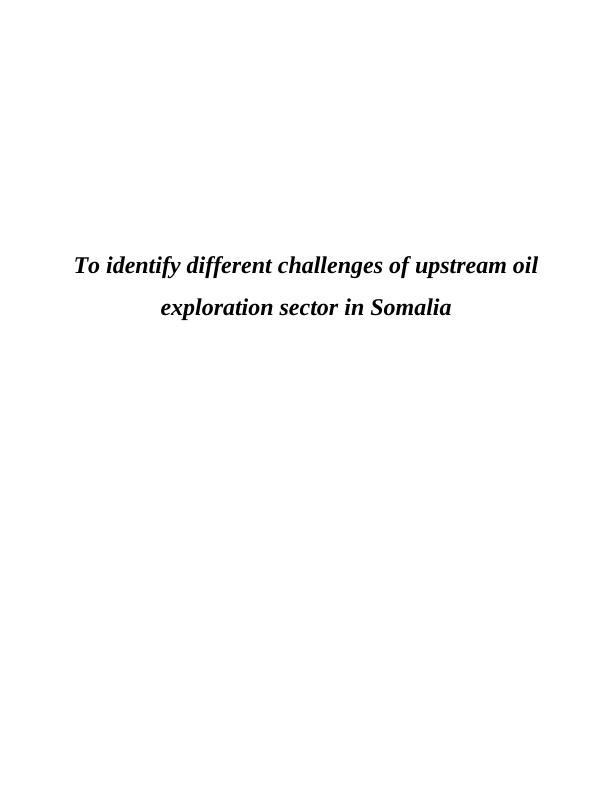
TABLE OF CONTENTS
chapter 1: introduction.....................................................................................................................1
1.1 Background............................................................................................................................1
1.2 Research aim and objectives..................................................................................................2
1.3 Organization (structure) of the study.....................................................................................3
Chapter 2: Literature Review...........................................................................................................5
Literature review..........................................................................................................................5
2.1 Historical context...................................................................................................................5
2.2 Social.....................................................................................................................................6
2.3 Environmental challenges......................................................................................................7
2.4 Federalism..............................................................................................................................9
2.5 Resource Curse......................................................................................................................9
2.6 Economic...............................................................................................................................9
2.7 Technological......................................................................................................................10
2.8 Research gap........................................................................................................................10
Chapter 3: Research Methodology................................................................................................12
3.1 Research Design..................................................................................................................12
3.2 Research strategy:................................................................................................................13
3.3 Data Collection....................................................................................................................13
3.4 Data Analysis and Presentation...........................................................................................14
3.5 Reliability and Validity of Data...........................................................................................15
3.6 Limitations...........................................................................................................................15
3.7 Ethical issues and considerations.........................................................................................16
Chapter 4: Data analysis................................................................................................................17
Data analysis introduction.........................................................................................................17
4.1 Political................................................................................................................................17
4.2 Institutional Challenge.........................................................................................................18
4.3 Resource Curse....................................................................................................................19
4.4 Corruption............................................................................................................................20
chapter 1: introduction.....................................................................................................................1
1.1 Background............................................................................................................................1
1.2 Research aim and objectives..................................................................................................2
1.3 Organization (structure) of the study.....................................................................................3
Chapter 2: Literature Review...........................................................................................................5
Literature review..........................................................................................................................5
2.1 Historical context...................................................................................................................5
2.2 Social.....................................................................................................................................6
2.3 Environmental challenges......................................................................................................7
2.4 Federalism..............................................................................................................................9
2.5 Resource Curse......................................................................................................................9
2.6 Economic...............................................................................................................................9
2.7 Technological......................................................................................................................10
2.8 Research gap........................................................................................................................10
Chapter 3: Research Methodology................................................................................................12
3.1 Research Design..................................................................................................................12
3.2 Research strategy:................................................................................................................13
3.3 Data Collection....................................................................................................................13
3.4 Data Analysis and Presentation...........................................................................................14
3.5 Reliability and Validity of Data...........................................................................................15
3.6 Limitations...........................................................................................................................15
3.7 Ethical issues and considerations.........................................................................................16
Chapter 4: Data analysis................................................................................................................17
Data analysis introduction.........................................................................................................17
4.1 Political................................................................................................................................17
4.2 Institutional Challenge.........................................................................................................18
4.3 Resource Curse....................................................................................................................19
4.4 Corruption............................................................................................................................20
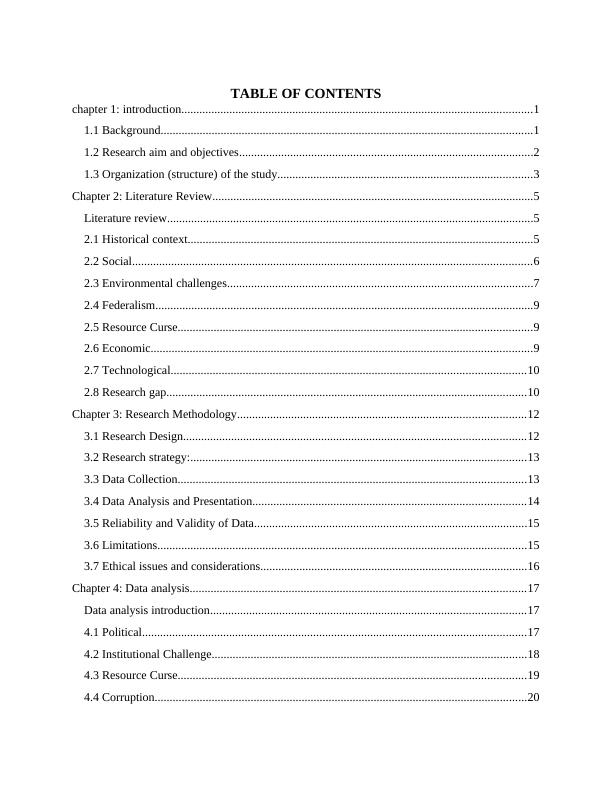
4.5 Dutch Disease......................................................................................................................20
4.6 Stability................................................................................................................................21
4.7 Summery..............................................................................................................................21
Chapter 5: Conclusion and Recommendations..............................................................................23
Chapter 6: Reflection.....................................................................................................................26
references.......................................................................................................................................28
4.6 Stability................................................................................................................................21
4.7 Summery..............................................................................................................................21
Chapter 5: Conclusion and Recommendations..............................................................................23
Chapter 6: Reflection.....................................................................................................................26
references.......................................................................................................................................28
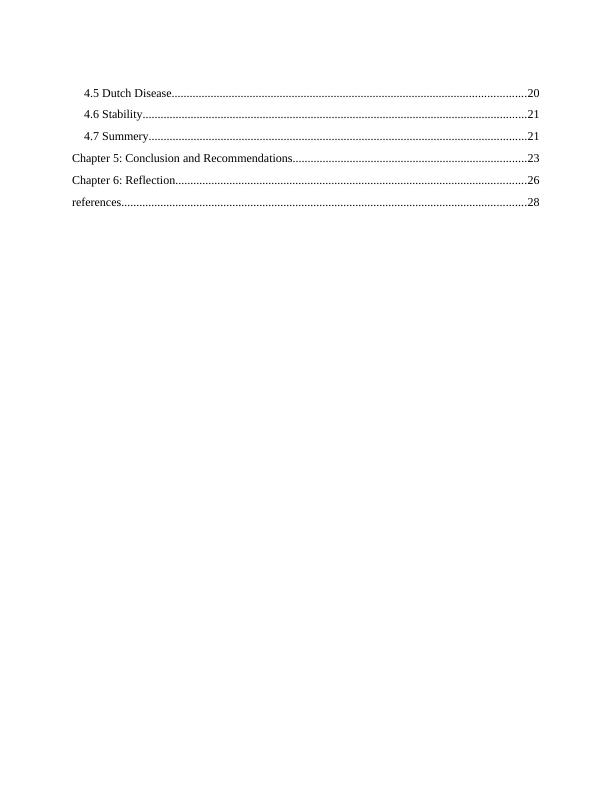
CHAPTER 1: INTRODUCTION
1.1 Background
Modern society cannot work smoothly without oil and gas. This is the major reason
behind the increment in demand of oil and gas exploration. There are three types of oil
exploration which are Upstream, Midstream and Downstream sector. Among these, upstream
sector focuses on discovery or exploration of crude oil (Texas, 2013). Downstream sector
includes the process of refining of crude oil which is discovered in upstream sector. The current
research has chosen Somalia for the whole investigation because it is one of the leading countries
of Africa which is exploring crude oil. At present, no industry can operate without
implementation of information technology. Oil industry also uses latest and expensive techniques
for exploring crude oil (Top 10 challenges in Oil and Gas industry, 2016). But, it is associated
with lots of issues that are relevant to management and technologies, increment in production of
liquid fuels, source of crude oil, operational challenges, energy demand and supply,
environmental pollution, fluctuating crude prices, economic uncertainty, shortage of people and
marketing issues, etc. Therefore, all these challenges are also affecting the upstream oil
exploration process of Somalia. So, researcher has decided to conduct study on different
challenges of upstream oil exploration sector in Somalia (Somalia upstream summary, 2016).
Oil and gas exploration is one of the major potential for Somalia which has attracted
large number of investors and oil exploration companies to search for oil and gas. In early 1950s
Italian (Agip) and American (Sinclair Oil Corporation) started research and study on petroleum
geology of Somalia. From 1960 to 1969 most of the companies were coming to Somalia for
exploring oil and gas. Sinclair Oil Corporation drilled 50 wells in South for the purpose of oil
exploration. Similarly Agip worked from mid-fifties to mid-sixties but they were not successful
for providing a commercial delivery of oil but in eighties they also discover 31 block for oil
exploration. According to the history of Somalia first well was explored in 1956 and it is known
as Sagaleh-1. At the end of the 2012 total 63 wells have been drilled (Somali Civil War, 2016).
Somalia has huge potential of oil exploration but there are number of reasons because of
them Somalia was under-explored and neglected for so long. Political reason and instability is
considered as major reasons because in January 1991 Somali government was collapsed and
country needed to face civil war. Due to such kind of political instability most of the oil
companies declared to return back. Including this, boom of oil was already declared in Middle
1 | P a g e
1.1 Background
Modern society cannot work smoothly without oil and gas. This is the major reason
behind the increment in demand of oil and gas exploration. There are three types of oil
exploration which are Upstream, Midstream and Downstream sector. Among these, upstream
sector focuses on discovery or exploration of crude oil (Texas, 2013). Downstream sector
includes the process of refining of crude oil which is discovered in upstream sector. The current
research has chosen Somalia for the whole investigation because it is one of the leading countries
of Africa which is exploring crude oil. At present, no industry can operate without
implementation of information technology. Oil industry also uses latest and expensive techniques
for exploring crude oil (Top 10 challenges in Oil and Gas industry, 2016). But, it is associated
with lots of issues that are relevant to management and technologies, increment in production of
liquid fuels, source of crude oil, operational challenges, energy demand and supply,
environmental pollution, fluctuating crude prices, economic uncertainty, shortage of people and
marketing issues, etc. Therefore, all these challenges are also affecting the upstream oil
exploration process of Somalia. So, researcher has decided to conduct study on different
challenges of upstream oil exploration sector in Somalia (Somalia upstream summary, 2016).
Oil and gas exploration is one of the major potential for Somalia which has attracted
large number of investors and oil exploration companies to search for oil and gas. In early 1950s
Italian (Agip) and American (Sinclair Oil Corporation) started research and study on petroleum
geology of Somalia. From 1960 to 1969 most of the companies were coming to Somalia for
exploring oil and gas. Sinclair Oil Corporation drilled 50 wells in South for the purpose of oil
exploration. Similarly Agip worked from mid-fifties to mid-sixties but they were not successful
for providing a commercial delivery of oil but in eighties they also discover 31 block for oil
exploration. According to the history of Somalia first well was explored in 1956 and it is known
as Sagaleh-1. At the end of the 2012 total 63 wells have been drilled (Somali Civil War, 2016).
Somalia has huge potential of oil exploration but there are number of reasons because of
them Somalia was under-explored and neglected for so long. Political reason and instability is
considered as major reasons because in January 1991 Somali government was collapsed and
country needed to face civil war. Due to such kind of political instability most of the oil
companies declared to return back. Including this, boom of oil was already declared in Middle
1 | P a g e
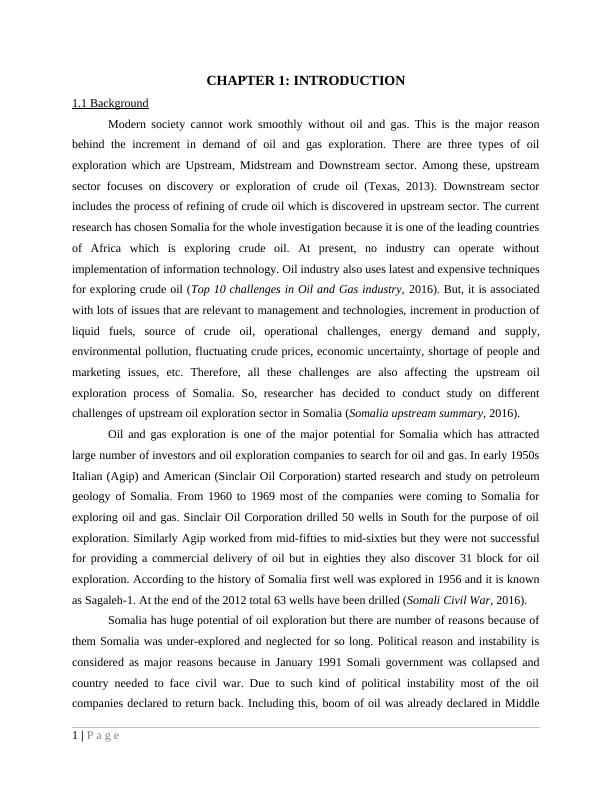
East and then West Africa but for exploring oil in Somalia every Oil company needs to have
large number of resources (Somalia Oil and Gas Potential, 2016). These companies were very
busy in West Africa and Middle East and South. So, it was also known as major reason behind
the low under-exploration of oil in Somalia. Including this, low drilling density and well density
is also known as reason of low oil exploration in Somalia because none of these wells have been
successful in commercial manner although some have had shown hydrocarbon shows. Including
this, distance between one well to another is also very long which also affect the exploration
process of number of oil exploration companies. Somali Civil Was which is known as armed
conflicts which is started in 1991 which is also one of the major reason which affect the
government decisions and policies towards the oil exploration. Due to this civil war investors do
not try to invest in Somalia oil exploration process. Including this, Transitional Federal
Government has provided a legal warning to investors and oil exploration firms to not make any
deal until the strong political and social stability in whole country (Somalia Oil and Gas
Potential, 2016). So, it is also recognised as a major reason because of it oil exploration remains
in a controversial stage. Consequently, researcher has decided to conduct investigation on similar
subject.
1.2 Research aim and objectives
Aim:
“To identify different challenges of the upstream oil exploration sector in Somalia”
Objectives:
To understand the meaning and concept of upstream oil exploration.
To critically analyse the major issues that may occur at the time of upstream oil
exploration in Somalia.
To determine different factors which may create different issues in upstream oil
exploration in Somalia. To suggest appropriate solutions to overcome different challenges associated with the
upstream oil exploration in Somalia.
Research questions:
1. What is the meaning of upstream oil exploration?
2 | P a g e
large number of resources (Somalia Oil and Gas Potential, 2016). These companies were very
busy in West Africa and Middle East and South. So, it was also known as major reason behind
the low under-exploration of oil in Somalia. Including this, low drilling density and well density
is also known as reason of low oil exploration in Somalia because none of these wells have been
successful in commercial manner although some have had shown hydrocarbon shows. Including
this, distance between one well to another is also very long which also affect the exploration
process of number of oil exploration companies. Somali Civil Was which is known as armed
conflicts which is started in 1991 which is also one of the major reason which affect the
government decisions and policies towards the oil exploration. Due to this civil war investors do
not try to invest in Somalia oil exploration process. Including this, Transitional Federal
Government has provided a legal warning to investors and oil exploration firms to not make any
deal until the strong political and social stability in whole country (Somalia Oil and Gas
Potential, 2016). So, it is also recognised as a major reason because of it oil exploration remains
in a controversial stage. Consequently, researcher has decided to conduct investigation on similar
subject.
1.2 Research aim and objectives
Aim:
“To identify different challenges of the upstream oil exploration sector in Somalia”
Objectives:
To understand the meaning and concept of upstream oil exploration.
To critically analyse the major issues that may occur at the time of upstream oil
exploration in Somalia.
To determine different factors which may create different issues in upstream oil
exploration in Somalia. To suggest appropriate solutions to overcome different challenges associated with the
upstream oil exploration in Somalia.
Research questions:
1. What is the meaning of upstream oil exploration?
2 | P a g e
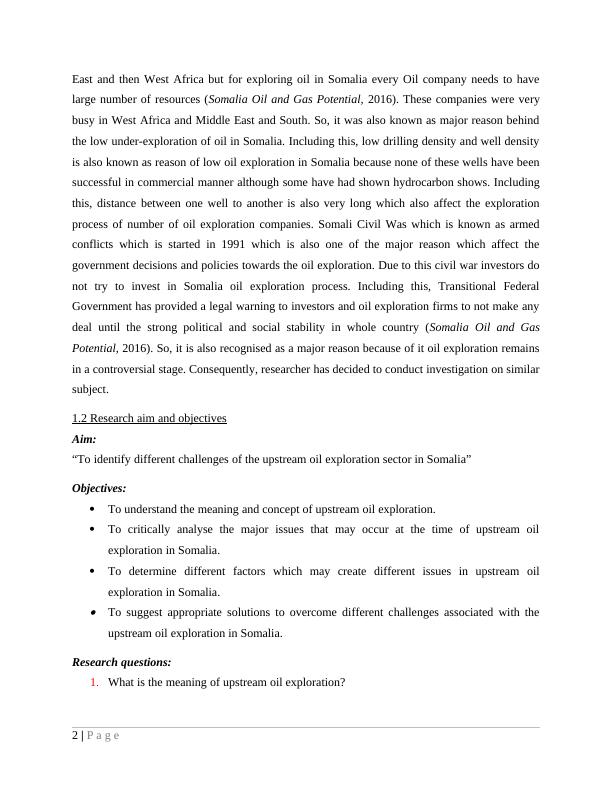
2. Which types of issues are faced by oil exploration firms at the time of drilling oil wells in
Somalia?
3. Why political and social instability in Somalia may create challenges for upstream oil
exploration in Somalia?
1.3 Organization (structure) of the study
Accomplishment of the current investigation is not an easy task for researcher. So, for
completing it in an effective manner, author has developed a plan for the structure of research.
So, whole structure of the current research study is described as under: Chapter 1 – Introduction: It is one of the important chapters which will help in providing
brief introduction about the whole research. It will help in understanding the research
problem of study. Further, it will communicate the major aim and objectives of current
investigation (McMillan and Schumacher, 2014). This chapter will also involve the
structure of whole dissertation that will be followed by researcher at the time of
conducing investigation on different challenges of the oil exploration upstream sector in
Somalia. Overall, it will provide a brief plan for the investigation. Chapter 2 – Literature review: For understanding the research problem effectually,
author will review available literature on similar subject which will be included in this
chapter. Therefore, it is a chapter which comprises of information of historical research
on similar subjects. It helps in getting insight to understand the research problem and
make assumptions for further research (Intawong and Berryman, 2015). This chapter will
determine the research gap which will play an important role in formulating the research
aim and objectives. Literature review will be completed by using different sources such
as website of company, journals, books, articles and blogs. These sources will be
effective for collecting the past information about research subject. Chapter 3 – Research Methodology: It is one of the most important chapters which play
an important role in conducting investigation effectually. It comprises of different tools,
techniques and methods for resolving the research issue and getting appropriate solution
(Devine and Severova, 2015). Researcher will involve different methods such as
philosophy, approach design and techniques with appropriate justification for the
selection. Including this, study will also include suitable methods of data collection on
the challenges of oil exploration upstream sector in Somalia. Therefore, it will prove to
3 | P a g e
Somalia?
3. Why political and social instability in Somalia may create challenges for upstream oil
exploration in Somalia?
1.3 Organization (structure) of the study
Accomplishment of the current investigation is not an easy task for researcher. So, for
completing it in an effective manner, author has developed a plan for the structure of research.
So, whole structure of the current research study is described as under: Chapter 1 – Introduction: It is one of the important chapters which will help in providing
brief introduction about the whole research. It will help in understanding the research
problem of study. Further, it will communicate the major aim and objectives of current
investigation (McMillan and Schumacher, 2014). This chapter will also involve the
structure of whole dissertation that will be followed by researcher at the time of
conducing investigation on different challenges of the oil exploration upstream sector in
Somalia. Overall, it will provide a brief plan for the investigation. Chapter 2 – Literature review: For understanding the research problem effectually,
author will review available literature on similar subject which will be included in this
chapter. Therefore, it is a chapter which comprises of information of historical research
on similar subjects. It helps in getting insight to understand the research problem and
make assumptions for further research (Intawong and Berryman, 2015). This chapter will
determine the research gap which will play an important role in formulating the research
aim and objectives. Literature review will be completed by using different sources such
as website of company, journals, books, articles and blogs. These sources will be
effective for collecting the past information about research subject. Chapter 3 – Research Methodology: It is one of the most important chapters which play
an important role in conducting investigation effectually. It comprises of different tools,
techniques and methods for resolving the research issue and getting appropriate solution
(Devine and Severova, 2015). Researcher will involve different methods such as
philosophy, approach design and techniques with appropriate justification for the
selection. Including this, study will also include suitable methods of data collection on
the challenges of oil exploration upstream sector in Somalia. Therefore, it will prove to
3 | P a g e

be very helpful in getting facts and determining appropriate results for the current
investigation. Chapter 4 – Data analysis: This chapter is effective for including interpretation of the
data analysis. Therefore, it will involve the actual findings and results that will help in
determining the solution of current research. Further, it will include information about the
suitable data analysis method for current study such as thematic or statistical analysis
(Wilson, 2016). Along with this, this chapter will take into account the information about
findings of research which will help in determining challenges of the oil exploration
upstream sector in Somalia. Chapter 5 – Conclusion: After analysing facts and figures by using appropriate data
analysis method, author will move towards making appropriate and meaningful
conclusion for the current investigation. So, this chapter will include final results and
conclusion of the whole study. In short, it will include all those challenges which are
faced by Somalia at the time of oil exploration (Gay, Mills and Airasian, 2011).
Framework and analysis:
For conducting this investigation, researcher will use different research methods which
will help in completing investigation in an effective manner. Positivism research philosophy will
be used by the researcher because it will focus on major objective such as challenges for
upstream oil exploration in Somalia (Garner and Scott, 2013). Further, study will focus on
descriptive research design because it plays a crucial role in completing both qualitative as well
as quantitative research. Qualitative research techniques will help in understanding the subjective
information and relevant theories and controversies which will play important role in
understanding research issues. On the other hand, quantitative research techniques will be
effective for resolving research issues using numerical information and analysis. Further,
research will use secondary data collection methods for obtaining facts and figures about the oil
exploration in Somalia. It will help in getting insights to understand different issues associated
with this process. Along with this, secondary data collection will be effective for collecting
historical information about Somalia and its oil exploration process. Afterwards, author will use
thematic analysis method for analysing the facts and figures. Overall, all these methods will be
very useful for completing the whole research study in an appropriate way (Creswell, 2013).
4 | P a g e
investigation. Chapter 4 – Data analysis: This chapter is effective for including interpretation of the
data analysis. Therefore, it will involve the actual findings and results that will help in
determining the solution of current research. Further, it will include information about the
suitable data analysis method for current study such as thematic or statistical analysis
(Wilson, 2016). Along with this, this chapter will take into account the information about
findings of research which will help in determining challenges of the oil exploration
upstream sector in Somalia. Chapter 5 – Conclusion: After analysing facts and figures by using appropriate data
analysis method, author will move towards making appropriate and meaningful
conclusion for the current investigation. So, this chapter will include final results and
conclusion of the whole study. In short, it will include all those challenges which are
faced by Somalia at the time of oil exploration (Gay, Mills and Airasian, 2011).
Framework and analysis:
For conducting this investigation, researcher will use different research methods which
will help in completing investigation in an effective manner. Positivism research philosophy will
be used by the researcher because it will focus on major objective such as challenges for
upstream oil exploration in Somalia (Garner and Scott, 2013). Further, study will focus on
descriptive research design because it plays a crucial role in completing both qualitative as well
as quantitative research. Qualitative research techniques will help in understanding the subjective
information and relevant theories and controversies which will play important role in
understanding research issues. On the other hand, quantitative research techniques will be
effective for resolving research issues using numerical information and analysis. Further,
research will use secondary data collection methods for obtaining facts and figures about the oil
exploration in Somalia. It will help in getting insights to understand different issues associated
with this process. Along with this, secondary data collection will be effective for collecting
historical information about Somalia and its oil exploration process. Afterwards, author will use
thematic analysis method for analysing the facts and figures. Overall, all these methods will be
very useful for completing the whole research study in an appropriate way (Creswell, 2013).
4 | P a g e
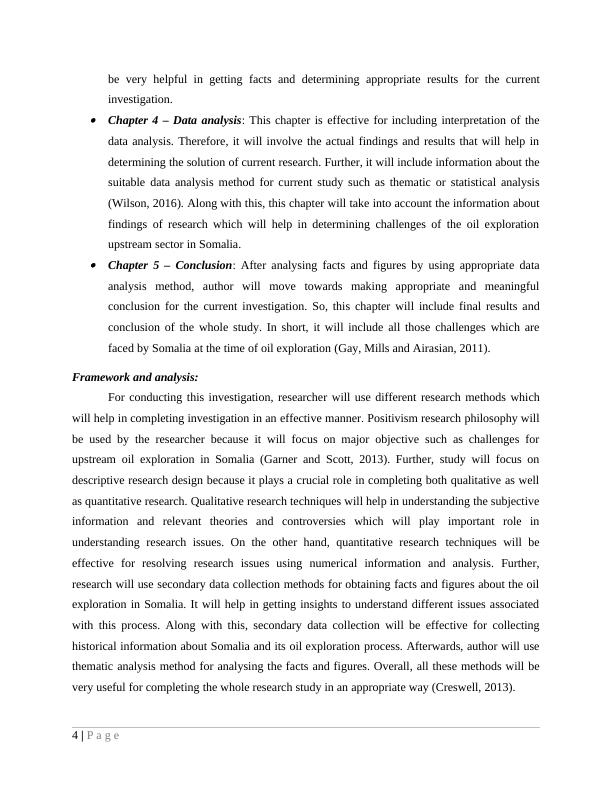
CHAPTER 2: LITERATURE REVIEW
Literature review
Literature review can be defined as a process of obtaining historical data about the similar
research subject from all those research papers which have conducted by researcher in the past. It
helps in getting insights to understand the research problem in effective manner by which author
can easily develop appropriate hypothesis or solution of every research question. The current
research project focuses on different challenges which are associated with the upstream oil
exploration process in Somalia (Chengzao, Zheng and Zhang, 2012). So, for understanding the
research issue author will focus on different process of oil exploration in Somalia such as
upstream process which is used by number of foreign companies for exploring oil in Somalia.
Along with this, researcher will also review the available literature on different factors which
may create issue and problems in upstream oil exploration in Somalia. Further, for better
understanding study will also include past research studies and their findings for challenges and
problems may occur at the time of upstream oil exploration in Somalia. There are lots of
literature which will help in getting solution of the research question using these types of articles
author will suggest appropriate solutions to overcome different challenges associated with the
upstream oil exploration in Somalia (Davies and et.al, 2014). Therefore, review of literature will
help in determining research gap for the current investigation which will play important role in
deciding research methods and analyzing appropriate facts and figures in effective manner.
There are several reasons due to which oil and gas exploration is not done in Somalia.
Here, investment is done by foreign investor to rebuild and abundant natural resources in
different areas like agriculture, livestock and oil and gas. Somalia is under developed economy in
terms of infrastructure, technology, politics and at economic level. There are number of
challenges that is faced by Somalia which results in underdevelopment. The another reason is
trade difficulties. Somalia has no trade agreement with US and European Union which leads to
facing issues to local firms. At Somalia, the issues related with oil and gas industry is that the
Federal government of Somalia and regional administration has no relation with each other. It
remains unclear messages and information. Technical issues are there at Somalia because the
economy is under developed where infrastructure and technology is not innovative.
5 | P a g e
Literature review
Literature review can be defined as a process of obtaining historical data about the similar
research subject from all those research papers which have conducted by researcher in the past. It
helps in getting insights to understand the research problem in effective manner by which author
can easily develop appropriate hypothesis or solution of every research question. The current
research project focuses on different challenges which are associated with the upstream oil
exploration process in Somalia (Chengzao, Zheng and Zhang, 2012). So, for understanding the
research issue author will focus on different process of oil exploration in Somalia such as
upstream process which is used by number of foreign companies for exploring oil in Somalia.
Along with this, researcher will also review the available literature on different factors which
may create issue and problems in upstream oil exploration in Somalia. Further, for better
understanding study will also include past research studies and their findings for challenges and
problems may occur at the time of upstream oil exploration in Somalia. There are lots of
literature which will help in getting solution of the research question using these types of articles
author will suggest appropriate solutions to overcome different challenges associated with the
upstream oil exploration in Somalia (Davies and et.al, 2014). Therefore, review of literature will
help in determining research gap for the current investigation which will play important role in
deciding research methods and analyzing appropriate facts and figures in effective manner.
There are several reasons due to which oil and gas exploration is not done in Somalia.
Here, investment is done by foreign investor to rebuild and abundant natural resources in
different areas like agriculture, livestock and oil and gas. Somalia is under developed economy in
terms of infrastructure, technology, politics and at economic level. There are number of
challenges that is faced by Somalia which results in underdevelopment. The another reason is
trade difficulties. Somalia has no trade agreement with US and European Union which leads to
facing issues to local firms. At Somalia, the issues related with oil and gas industry is that the
Federal government of Somalia and regional administration has no relation with each other. It
remains unclear messages and information. Technical issues are there at Somalia because the
economy is under developed where infrastructure and technology is not innovative.
5 | P a g e
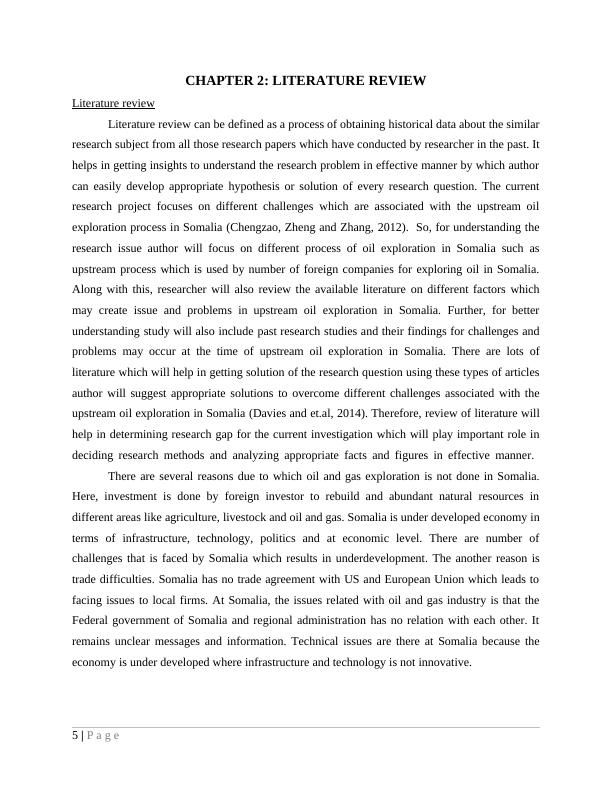
End of preview
Want to access all the pages? Upload your documents or become a member.
Related Documents
Environmental Management and Sustainability Assignmentlg...
|10
|3025
|100
Impact of Crude Oil Transportation on Tanker Marketlg...
|40
|11230
|23
The Impact of Crude Oil Prices on UK based Exploration & Production Companieslg...
|54
|13064
|105
Assignment on Supply Chain Management in Nigerialg...
|60
|13770
|39
Logistics and Supply Chain Management of Petroleumlg...
|48
|16570
|20
Environmental Impact of Shell’s Oil and Gas on Land : Case Study of Niger-Deltalg...
|42
|12754
|100
